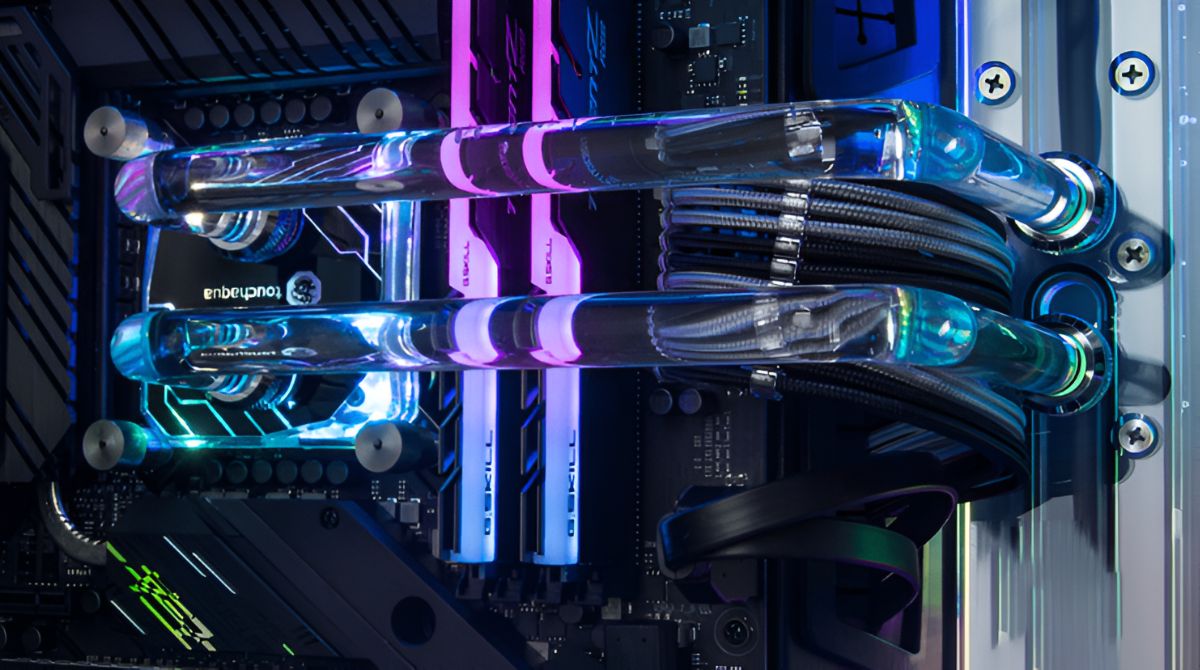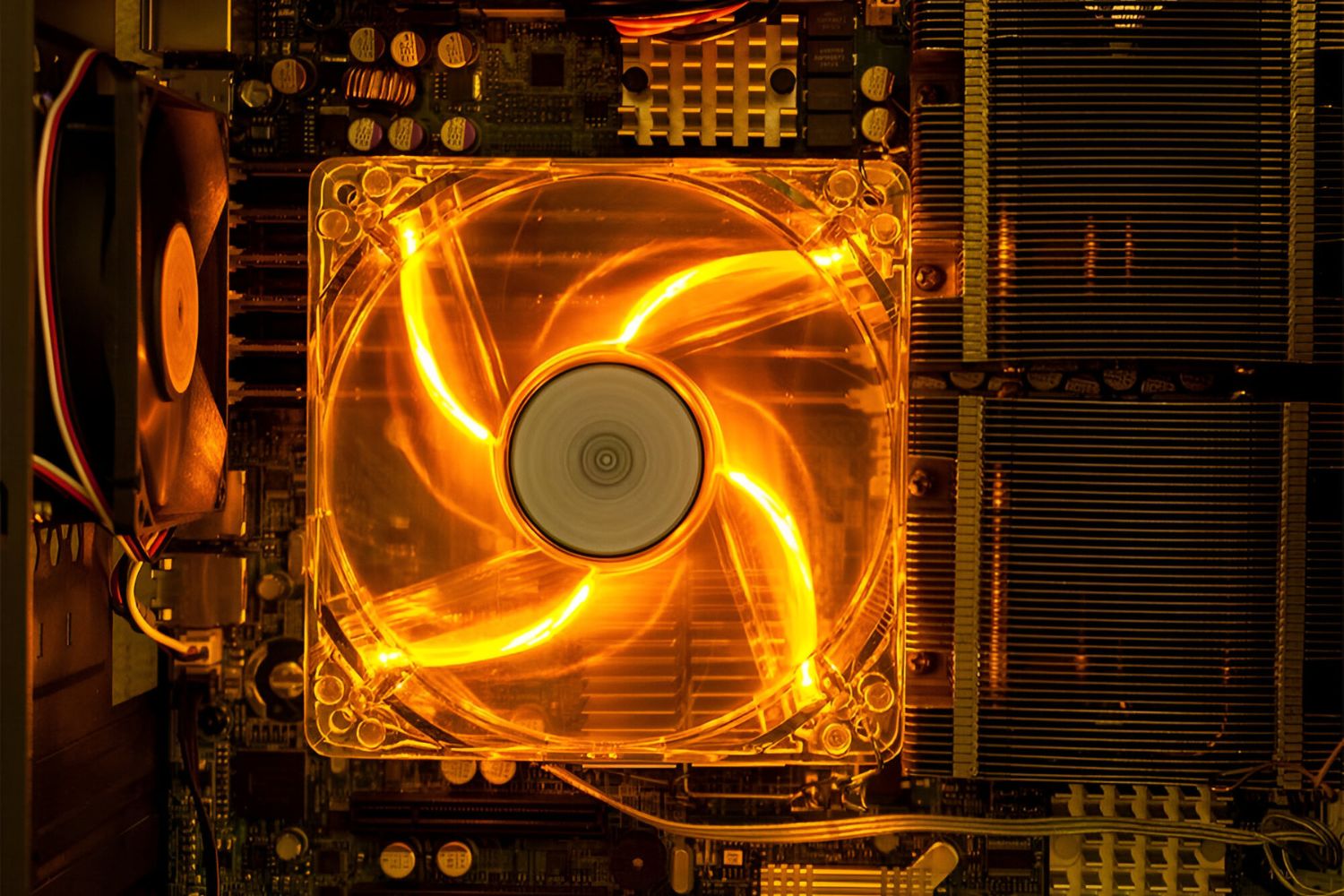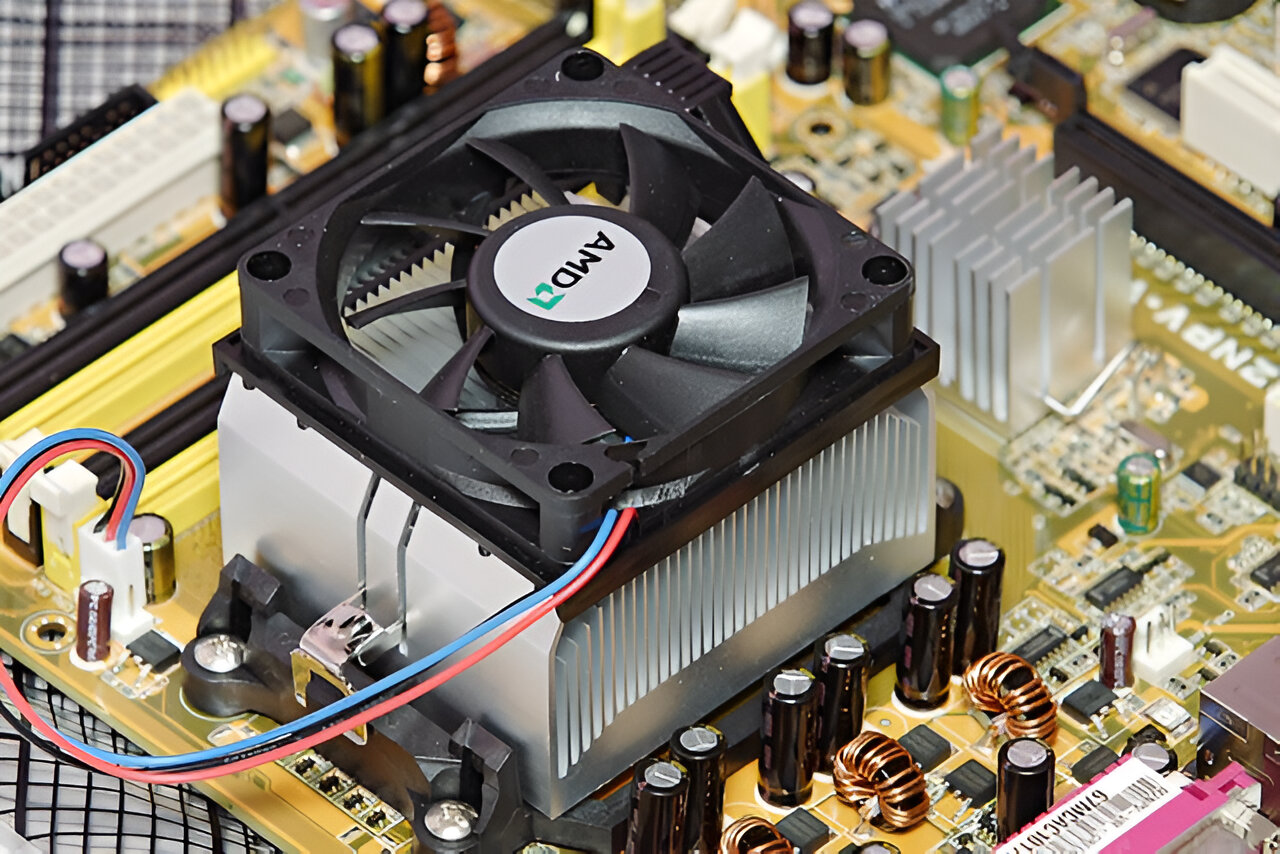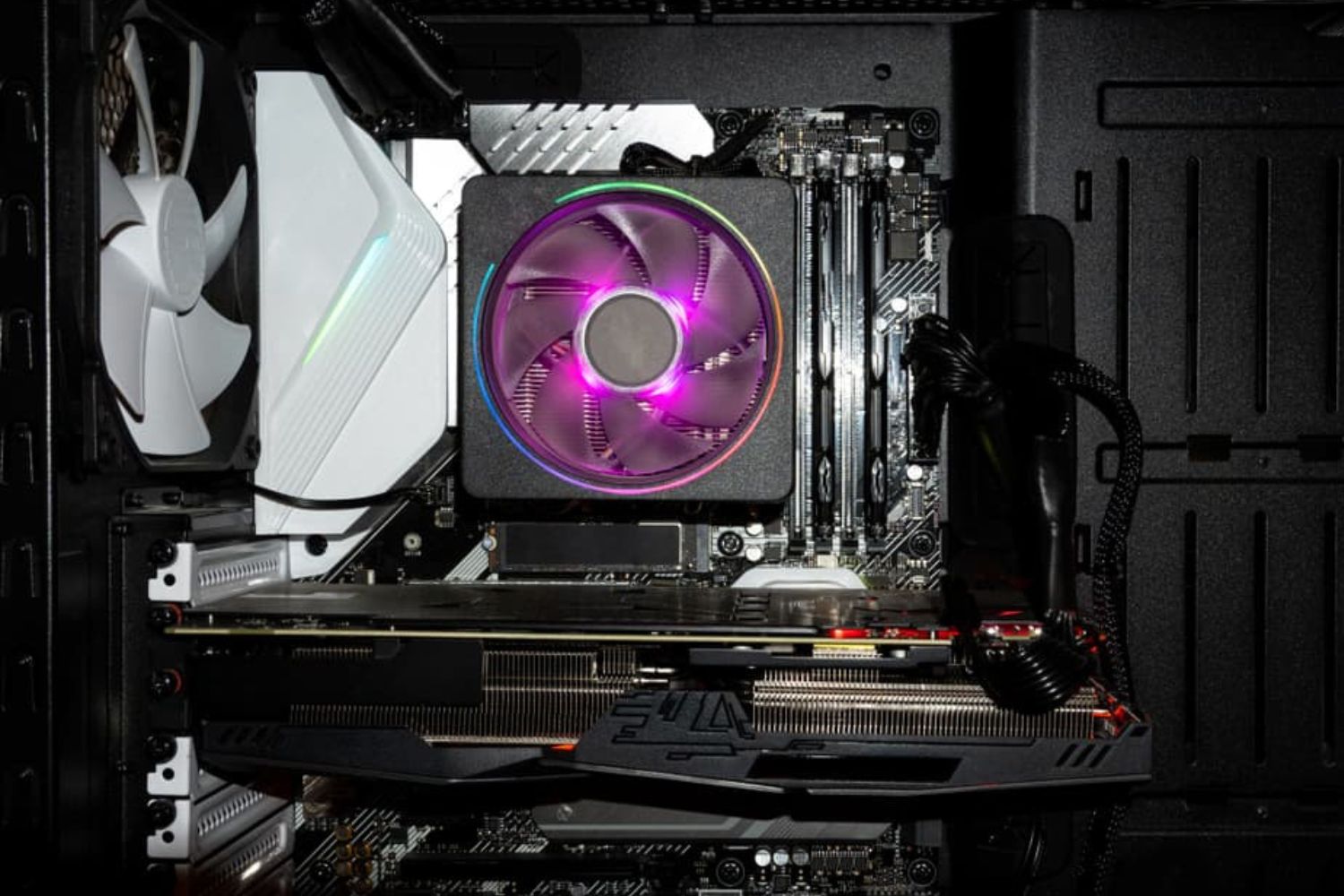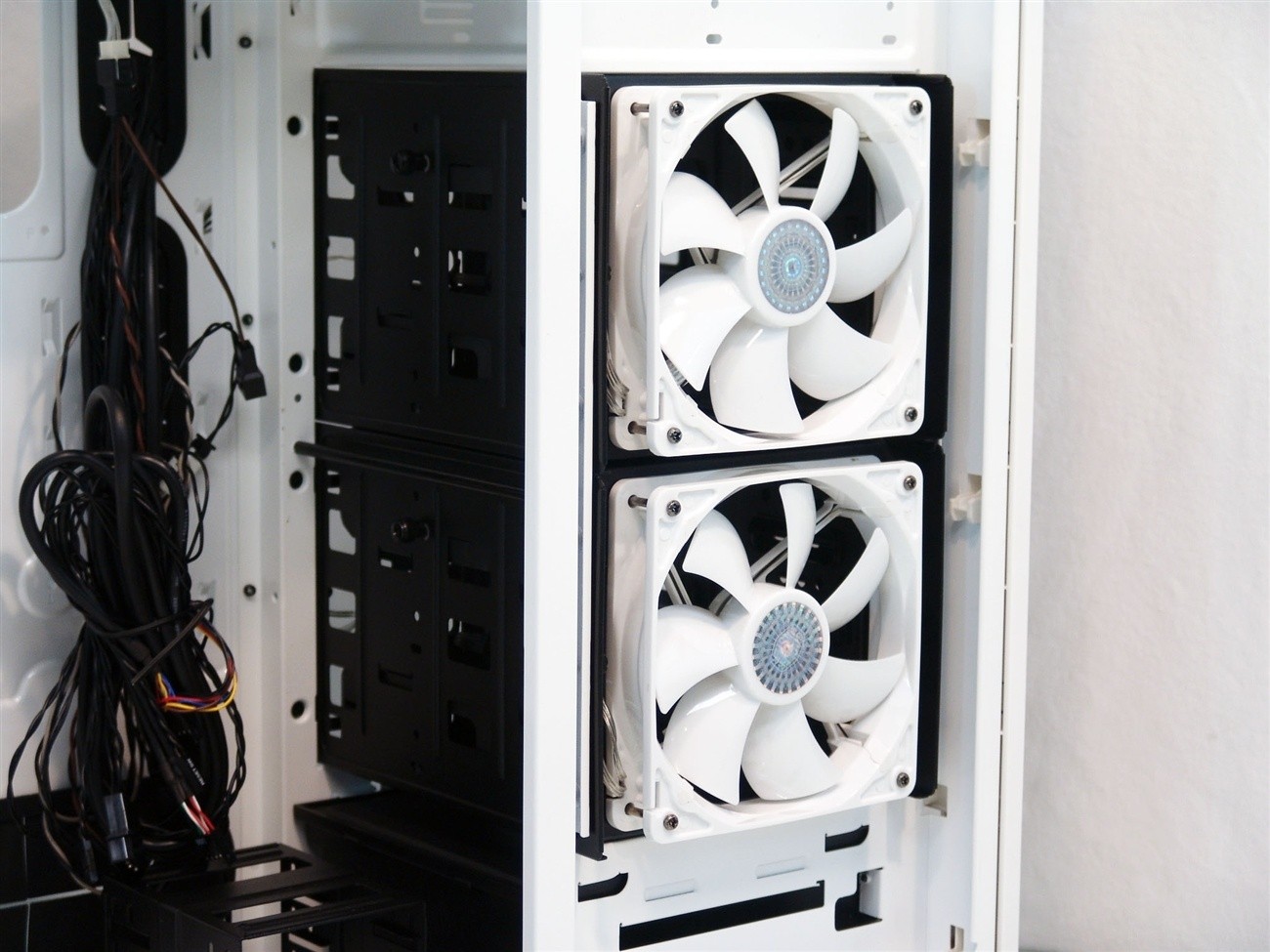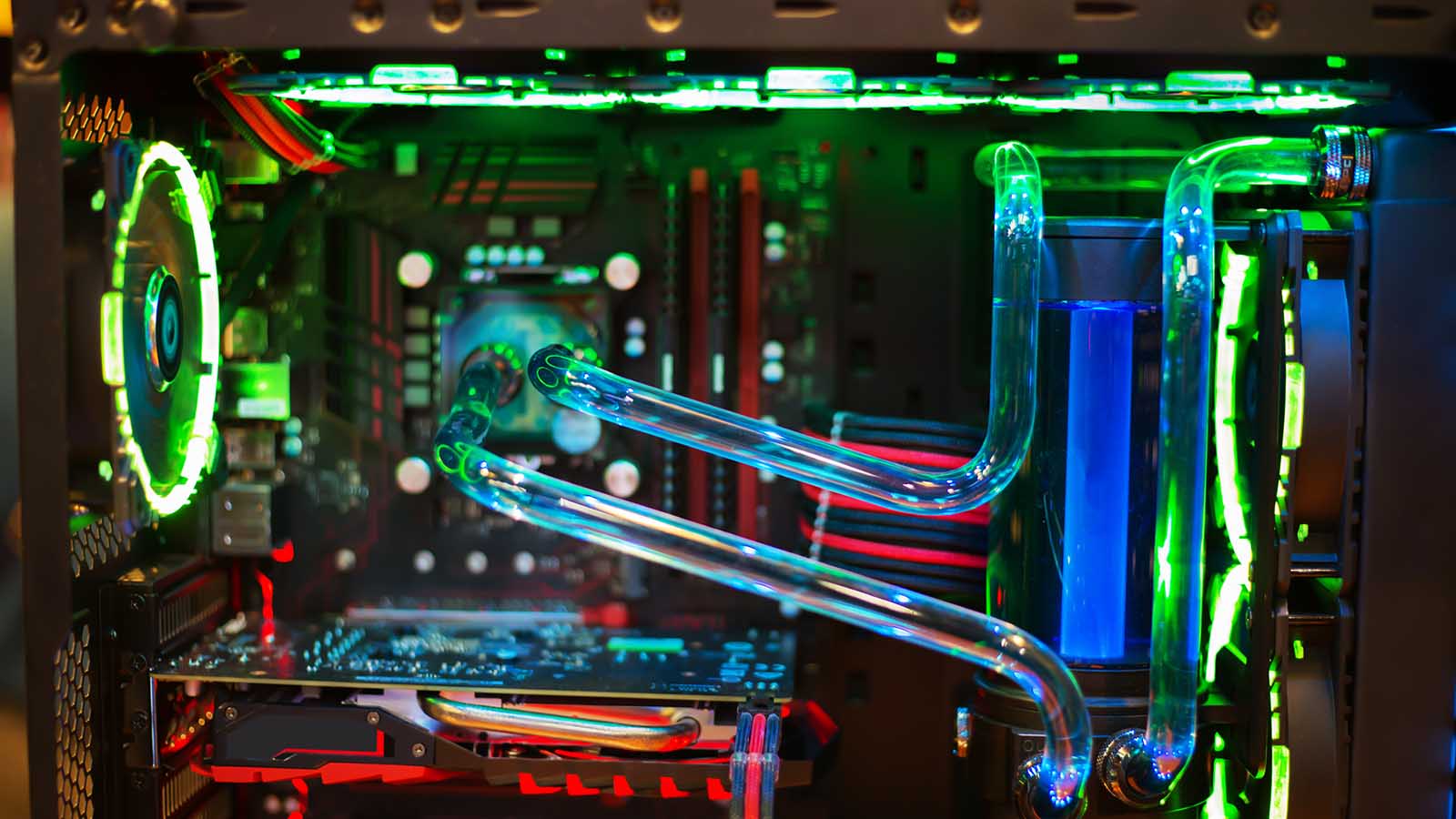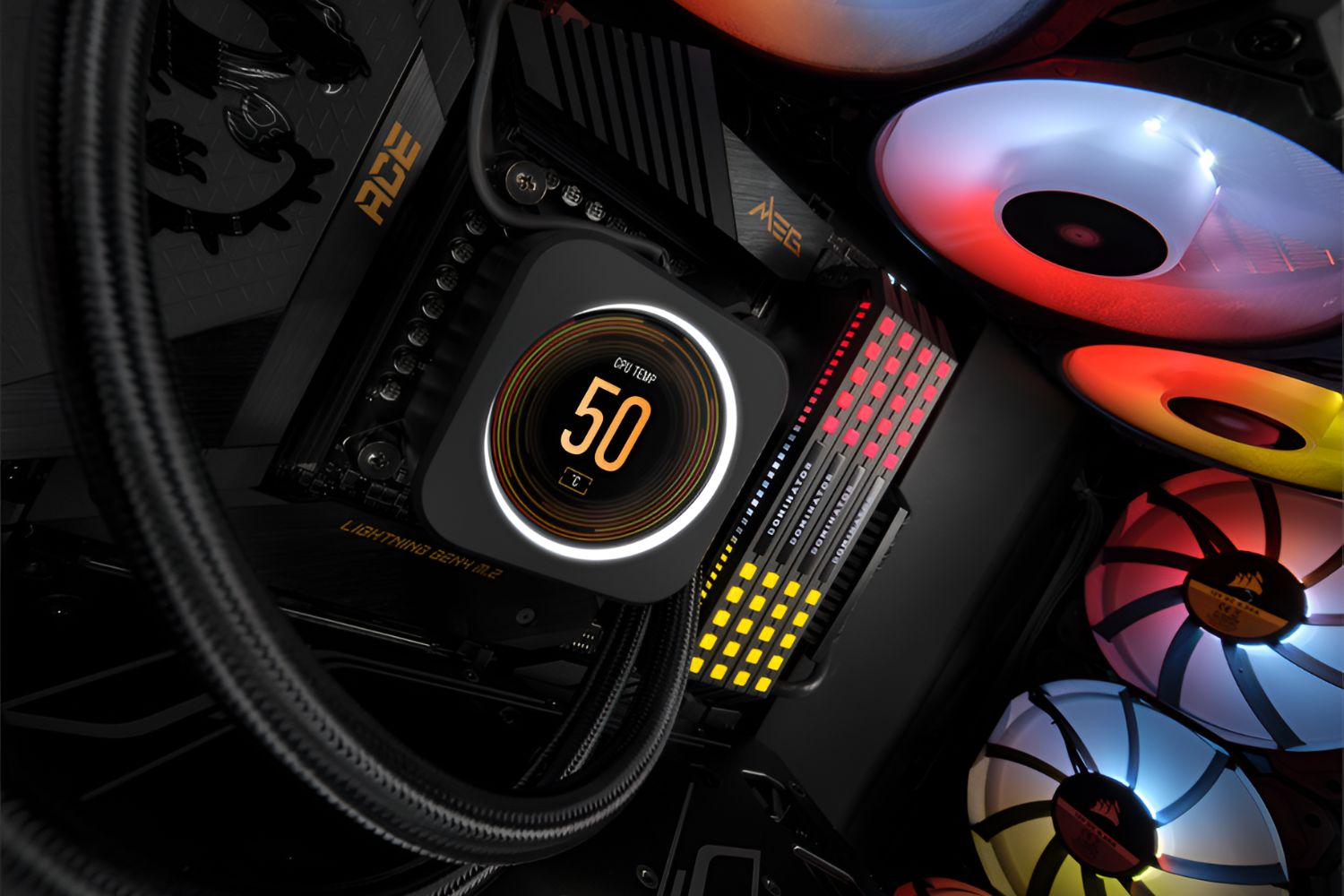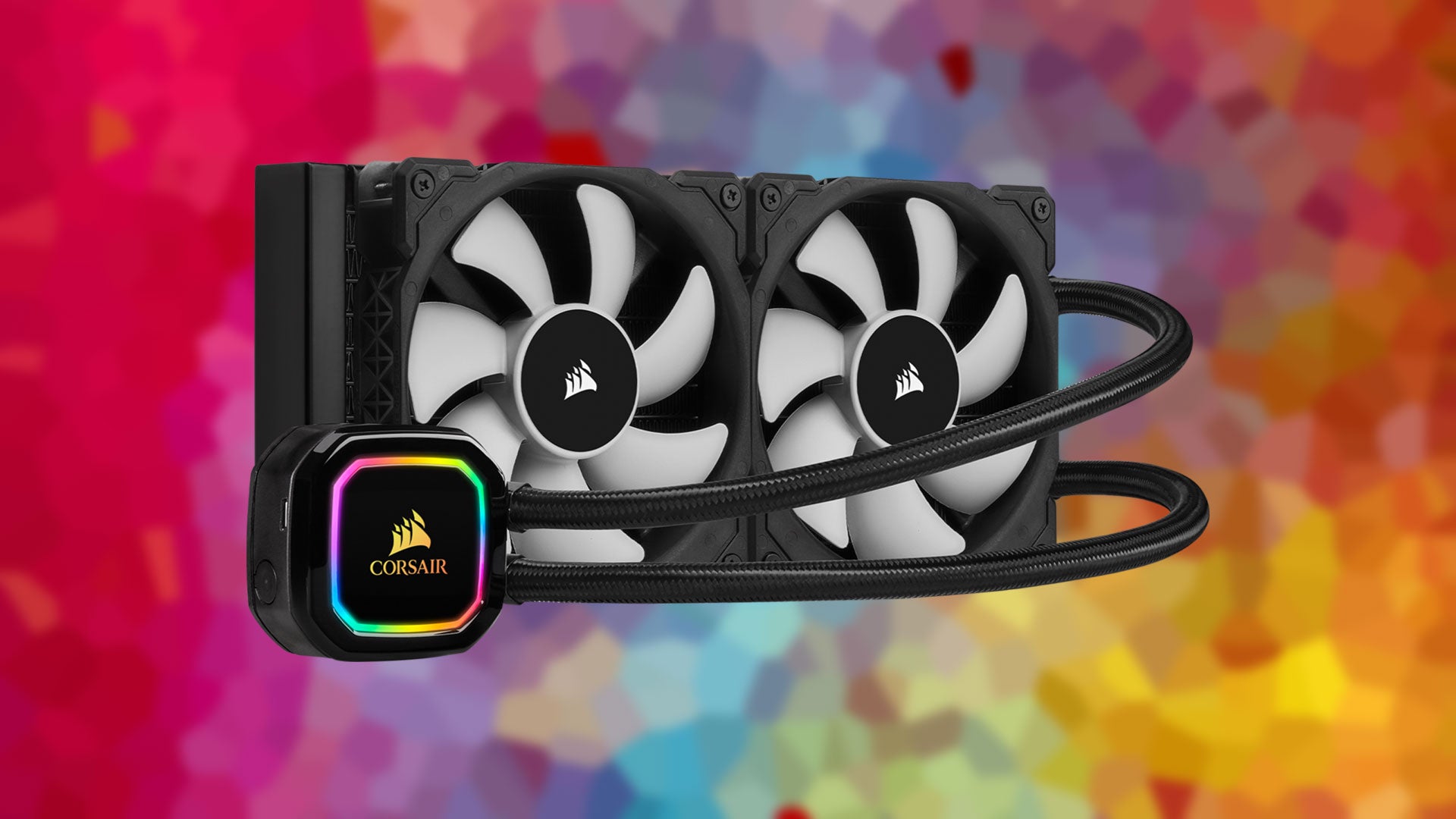Introduction
The central processing unit (CPU) is the heart and brain of a computer, responsible for executing instructions and performing calculations. However, the more powerful a CPU becomes, the more heat it generates. Excessive heat can cause performance issues and even damage the CPU. To prevent this, cooling solutions are required to maintain optimal operating temperatures.
One popular cooling method is air cooling, which involves using fans and heat sinks to dissipate heat. While air cooling is effective for most CPUs, it may not be sufficient for high-performance systems or overclocked processors. This is where liquid cooling comes into play.
Liquid cooling offers a more efficient and effective way to manage CPU temperatures. Instead of relying solely on airflow, liquid coolers use a closed-loop system that circulates a liquid coolant to absorb heat from the CPU. This liquid then transfers the heat to a radiator, where it is dissipated into the surrounding environment.
The benefits of liquid cooling are numerous. Firstly, it provides better thermal performance compared to air cooling. Liquid coolers are capable of dissipating heat more effectively, resulting in lower operating temperatures and higher overall system stability.
Additionally, liquid cooling is often quieter than air cooling. Since fans play a crucial role in dissipating heat in air coolers, they can generate a significant amount of noise. Liquid coolers, on the other hand, have larger radiator surfaces and slower fan speeds, resulting in quieter operation.
Furthermore, liquid cooling offers greater flexibility in terms of installation. Traditional air coolers can sometimes obstruct memory or PCIe slots, limiting the choice of components. Liquid coolers, with their compact and flexible designs, can be mounted in various configurations to fit different system setups.
There are several different types of liquid coolers available on the market. All-in-one (AIO) coolers come preassembled and require minimal installation. They are user-friendly and provide good performance, making them a popular choice for many users. Custom liquid cooling loops, on the other hand, offer the highest level of performance and customization but require more effort and expertise to set up.
Choosing the right liquid for your cooler is crucial. The coolant serves two main purposes: transferring heat away from the CPU and preventing corrosion or clogging in the system. There are various types of liquids available, including pre-mixed coolants and DIY options. Each type has its own advantages and considerations.
In the following sections, we will explore the different types of liquid coolers in more detail and discuss the importance of selecting the right liquid for optimal performance and longevity of your CPU cooling system.
Air vs Liquid Cooling
When it comes to cooling your CPU, you have two main options: air cooling and liquid cooling. Both methods are effective, but they have distinct differences in terms of performance, noise levels, installation, and aesthetics.
Air cooling, as the name suggests, uses fans and heat sinks to dissipate heat from the CPU. The heat sink is a metal component with fins that increase the surface area for heat dissipation. The fan blows air over the heat sink, which carries away the heat. Air cooling is cost-effective, easy to install, and generally sufficient for most CPUs that operate at stock clock speeds.
However, air cooling does have its limitations. As CPU power and heat generation increase, air coolers may struggle to keep up. Overclocking, which is the process of running a CPU at higher clock speeds than it is designed for, can significantly increase heat output and put a strain on air coolers. This can lead to higher operating temperatures and potential thermal throttling, where the CPU reduces its performance to prevent excessive heat buildup.
Liquid cooling, on the other hand, offers superior thermal performance and is more efficient at dissipating heat from the CPU. It utilizes a closed-loop system that consists of a water block, pump, radiator, and fans. The water block is a copper or aluminum plate that sits directly on the CPU and absorbs heat. The pump then circulates liquid coolant through tubes, transferring the heat to the radiator. The radiator, equipped with fans, dissipates the heat into the surrounding environment.
One of the primary advantages of liquid cooling is its ability to handle higher heat loads. Liquid coolers can effectively dissipate heat even in extreme conditions, making them ideal for high-performance systems and overclocking enthusiasts. They also offer better heat distribution, ensuring that all areas of the CPU receive sufficient cooling.
Moreover, liquid cooling tends to be quieter than air cooling. The larger radiator surface area and slower fan speeds of liquid coolers result in reduced noise levels. This is particularly beneficial for those who value a quiet computing experience, whether for office work, content creation, or gaming.
Installation can be a consideration when choosing between air and liquid cooling. Air coolers are generally easier to install, as they usually require a simple mounting mechanism and do not involve liquid coolant management. On the other hand, liquid coolers may require more effort and expertise to set up, especially in the case of custom cooling loops that involve assembling separate components and potentially routing tubes.
Aesthetics are another aspect to consider. Many liquid coolers feature RGB lighting effects and stylish designs that can enhance the overall appearance of your system. This is a significant selling point for PC enthusiasts who prioritize aesthetics and want to create visually stunning builds.
In summary, both air and liquid cooling have their strengths and weaknesses. Air cooling is cost-effective, easy to install, and suitable for most CPUs. However, liquid cooling provides superior thermal performance, quieter operation, and a more customizable and visually appealing solution. If you have a high-performance system or plan to overclock your CPU, liquid cooling is a recommended choice to ensure optimal cooling and stability.
Benefits of Liquid Cooling
Liquid cooling offers several advantages over traditional air cooling when it comes to keeping your CPU cool. These benefits make it a popular choice for enthusiasts, gamers, and users who demand high-performance computing. Let’s explore some of the key advantages of liquid cooling:
1. Enhanced Thermal Performance: Liquid cooling systems are designed to effectively dissipate heat from the CPU, resulting in lower operating temperatures. This allows the CPU to maintain optimal performance and prevents thermal throttling, ensuring smooth and stable operation even under heavy workloads or overclocked conditions.
2. Quieter Operation: Liquid coolers typically feature larger radiators and slower rotating fans. This combination reduces noise levels compared to air coolers, providing a quieter computing experience. Whether you’re working in a quiet office environment or gaming in your living room, liquid cooling allows you to keep noise levels to a minimum.
3. Greater Flexibility and Compatibility: Liquid cooling systems are available in various sizes and configurations, making them flexible and compatible with different computer cases and component layouts. Unlike air coolers, which can sometimes interfere with the installation of tall memory modules or obstruct expansion slots, liquid coolers provide more clearance and allow for easier customization of your system.
4. Improved Longevity: By maintaining lower temperatures, liquid cooling contributes to the longevity and overall lifespan of your CPU. Excessive heat can degrade the performance and reliability of your processor over time, while cooler operating temperatures help preserve its functionality and extend its lifespan.
5. Enhanced Overclocking Potential: Overclocking, the process of running a CPU at higher frequencies than its default settings, can significantly increase heat output. Liquid cooling excels at dissipating the extra heat generated during overclocking, allowing you to push your CPU to its limits for maximum performance without the risk of thermal throttling or instability.
6. Aesthetics and Customization: Liquid cooling systems often come with stylish designs, RGB lighting options, and transparent tubing that enhance the visual appeal of your computer. This appeals to PC enthusiasts who take pride in their builds and want to create a customized and visually stunning system.
7. Efficient Heat Distribution: Liquid coolers distribute heat more evenly across the entire CPU surface due to direct contact between the water block and the processor. This helps prevent hot spots and ensures that all areas of the CPU are effectively cooled, maximizing cooling efficiency and maintaining consistent performance.
8. Easy Maintenance: Maintaining a liquid cooling system is relatively straightforward. Most closed-loop liquid coolers require minimal maintenance, as they come pre-filled with a coolant that does not need to be replaced regularly. Some coolants are even formulated to prevent bacteria growth and system clogs, further reducing the need for maintenance.
In summary, liquid cooling offers numerous benefits, including improved thermal performance, quieter operation, compatibility with various system configurations, extended CPU lifespan, enhanced overclocking potential, customizable aesthetics, efficient heat distribution, and easy maintenance. These advantages make liquid cooling an attractive option for those seeking optimal cooling and performance for their CPUs.
Different Types of Liquid Coolers
When it comes to liquid cooling, there are several different types of coolers available on the market. Each type has its own advantages, installation requirements, and performance characteristics. Let’s explore the main types of liquid coolers:
1. All-in-One (AIO) Liquid Coolers: AIO liquid coolers are pre-assembled units that come with a water block, pump, radiator, and fans integrated into one package. They are easy to install and require minimal maintenance. AIO coolers are a popular choice for users who want the performance benefits of liquid cooling without the complexity of custom loops. They offer good cooling performance and are available in various sizes to fit different system configurations.
2. Custom Liquid Cooling Loops: Custom liquid cooling loops are the pinnacle of liquid cooling performance and customization. They involve assembling separate components, including a water block, pump, reservoir, radiator, tubing, and fittings. Custom loops provide better cooling performance compared to AIO coolers and allow for advanced customization, such as creating elaborate tubing runs and adding water blocks for graphics cards. However, they require more effort, expertise, and maintenance compared to AIO coolers.
3. Open-Loop Coolers: Open-loop liquid coolers are similar to custom loops but are designed for specific components, such as graphics cards or VRM (voltage regulator module) coolers. Unlike closed-loop AIO coolers, open-loop coolers require manual filling and maintenance. They offer better customization options and performance compared to AIO coolers but require more knowledge and care in setup and maintenance.
4. Phase Change Coolers: Phase change coolers are a less common type of liquid cooling solution. They utilize a refrigerant to cool the CPU, similar to how a refrigerator cools its interior. These coolers are more expensive and complex to install than AIO or custom loops, but they offer exceptional cooling performance. Phase change coolers can achieve extremely low temperatures, making them appealing for extreme overclocking or highly demanding applications.
5. Chillers: Chillers are a niche category of liquid coolers typically used in industrial or server environments. They work by removing heat from the liquid coolant through a compressor and cooling it using a heat exchanger. Chillers provide consistent and efficient cooling but are not designed for mainstream consumer use due to their high cost and complexity.
It’s important to consider your specific needs, budget, and technical expertise when choosing a liquid cooler. AIO coolers provide a hassle-free and effective cooling solution for most users, offering a balance between performance and convenience. Custom liquid cooling loops are ideal for those seeking maximum cooling performance and are willing to invest time and effort into setup and maintenance. Niche solutions like phase change coolers and chillers cater to specific requirements and are generally not necessary for most consumer-grade systems.
Ultimately, the type of liquid cooler you choose will depend on your cooling requirements, budget, aesthetic preferences, and willingness to invest time and effort. Assessing these factors will help you make an informed decision and ensure optimal cooling for your CPU.
The Importance of Choosing the Right Liquid
When it comes to liquid cooling systems, choosing the right coolant is of utmost importance. The coolant serves two crucial functions: transferring heat away from the CPU and preventing corrosion or clogging within the system. Selecting the appropriate liquid for your cooling system can have a significant impact on the overall performance, longevity, and reliability of your setup. Here are some key factors to consider:
1. Thermal Performance: The primary function of the liquid coolant is to efficiently absorb and carry away heat from the CPU. Opting for a high-quality coolant with excellent thermal conductivity ensures effective heat transfer, helping to keep your CPU operating at optimal temperatures. Look for coolants that have been specifically designed for liquid cooling systems and have been tested for thermal performance.
2. Corrosion Protection: Liquid coolants come into direct contact with various metal components in the system, such as the water block, radiator, and fittings. It is crucial to choose a coolant that provides proper corrosion protection to prevent the formation of rust and other corrosive materials. Look for coolants that contain corrosion inhibitors, as they help maintain the integrity and longevity of your cooling system.
3. Anti-Bacterial Properties: Bacteria growth within the liquid cooling system can lead to clogs, reduced coolant flow, and compromised thermal performance. Opting for a coolant that has anti-bacterial properties can help inhibit the growth of bacteria and maintain the cleanliness of your system. This is particularly important if you use a custom loop with open reservoirs and exposed fittings.
4. Compatibility: Ensure that the coolant you select is compatible with the materials used in your liquid cooling system. Different coolants may react differently with various metals, such as copper, aluminum, or nickel-plated surfaces. It is important to check the compatibility information provided by the coolant manufacturer and ensure it aligns with the components in your system to avoid any unwanted chemical reactions or damage.
5. Maintenance Considerations: Some coolants require periodic maintenance or replacement. Pre-mixed coolants typically have a longer lifespan and do not require frequent changes, making them more convenient for users who prefer a set-and-forget solution. DIY coolant options may require regular monitoring and may need to be replaced more frequently due to evaporation or degradation over time. Consider your willingness and ability to perform coolant maintenance when selecting the right liquid for your system.
6. Aesthetics: While aesthetics may not directly affect the performance of your liquid cooling system, they can add a visual appeal to your build. Some coolants come in various colors or even feature UV-reactive properties that can create stunning visual effects when paired with RGB lighting. Consider your personal preference and the overall theme of your build when choosing a coolant that matches your desired aesthetics.
By carefully choosing the right liquid coolant for your system, you can ensure optimal cooling performance, prevent corrosion and clogging, and prolong the lifespan of your liquid cooling components. Take into account the thermal properties, corrosion protection, compatibility, maintenance requirements, and even aesthetics to make an informed decision and maintain a reliable and efficient liquid cooling system.
Water Cooling
Water cooling is a type of liquid cooling that specifically utilizes water as the primary coolant in the system. While other coolants such as specialized liquids and refrigerants can be used, water cooling remains the most common and accessible option for most users. The use of water as a coolant offers several advantages and considerations, which we will explore in this section.
Thermal Conductivity: Water has excellent thermal conductivity, which means it is very efficient at transferring heat away from the CPU. Compared to other coolants, water provides superior heat dissipation capabilities, ensuring optimal cooling performance and lower operating temperatures for your CPU.
Availability and Cost: Water is readily available and cost-effective, making it an accessible option for users looking to explore liquid cooling. It can be easily acquired and is generally less expensive compared to specialized coolants. This makes water cooling an attractive choice for those on a budget or newcomers to liquid cooling.
Environmental Impact: Water is a safe and environmentally friendly option for liquid cooling. Unlike some specialized coolants that may contain hazardous or toxic chemicals, water is non-toxic and poses no harm if accidentally spilled or leaked. It also does not contribute to pollution when properly disposed of, making it a sustainable choice for liquid cooling systems.
Preventing Corrosion and Algae Growth: The use of water in a cooling loop can present some challenges in terms of corrosion and the growth of algae or other microorganisms. Corrosion can occur when water comes into contact with certain metals used in the cooling system, leading to degradation and potential failure over time. To mitigate corrosion, it is crucial to use proper corrosion inhibitors or coolants designed to prevent this issue. Additionally, employing anti-bacterial additives can help control the growth of algae and bacteria in the loop.
Leakage Risks: Water cooling systems, like any liquid cooling setup, come with the risk of potential leakage. If not properly installed or maintained, leaks can occur and lead to damage to components and other parts of the computer. It is essential to follow proper installation procedures, ensure the tightness of all fittings, and regularly inspect the system for any signs of leakage. Additionally, using high-quality tubing and fittings can help reduce the likelihood of leaks.
Conductivity Risks: Unlike specialized coolants, water is electrically conductive, which poses a potential risk if it comes into contact with electrical components. To mitigate this risk, it is crucial to ensure that all parts of the water cooling system are properly insulated and secured to prevent any accidental contact with sensitive electrical elements.
In summary, water cooling is a popular and accessible choice for liquid cooling systems. It offers excellent thermal conductivity, cost-effectiveness, and environmental friendliness. However, proper precautions must be taken to prevent corrosion, minimize the growth of algae and bacteria, and mitigate the risks of leakage and electrical conductivity. By addressing these considerations and using appropriate additives and maintenance practices, water cooling can provide efficient and reliable cooling for your CPU.
Pre-Mixed vs DIY Coolants
When it comes to selecting a liquid coolant for your liquid cooling system, you have the option of choosing between pre-mixed coolants or creating your own DIY mix. Both options have their advantages and considerations. Let’s delve into the differences between pre-mixed and DIY coolants:
Pre-Mixed Coolants: Pre-mixed coolants are ready-to-use solutions that come in sealed bottles. They are designed to deliver optimal performance without the need for additional mixing or customization. Here are some key points to consider:
- Convenience: Pre-mixed coolants offer a hassle-free solution for liquid cooling. They eliminate the need for measuring and mixing different components, making them easy to use, especially for beginners.
- Consistent Performance: Pre-mixed coolants are formulated to provide consistent performance and protection. Manufacturers carefully balance the coolant properties to ensure efficient heat transfer and corrosion inhibition.
- Warranty Considerations: Some liquid cooling component manufacturers provide warranties for their products when used with specific pre-mixed coolants. It is essential to check if using a specific pre-mixed coolant is necessary to maintain warranty coverage.
- Limited Customization: Pre-mixed coolants typically come in a range of colors and may offer UV-reactive or transparent options. However, if you desire a specific color or want to create custom effects, pre-mixed coolants may not provide the level of customization you seek.
- Longevity: Pre-mixed coolants often have longer lifespans compared to DIY coolants. They are formulated to resist evaporation, degradation, and bacterial growth, reducing the need for frequent coolant changes.
DIY Coolants: DIY coolants involve mixing various components to create a customized coolant solution. This option offers more flexibility and customization but requires careful consideration and attention to detail:
- Customization: With DIY coolants, you have full control over creating the desired color, opacity, and effects. This allows you to match your system’s aesthetics or experiment with unique looks.
- Compatibility: When creating a DIY coolant, it is crucial to ensure the compatibility of the components you are mixing. Different formulations and concentrations can have varying effects on system performance, corrosion resistance, and longevity.
- Maintenance: DIY coolants may require more frequent maintenance compared to pre-mixed coolants. This can involve regular monitoring of coolant levels, pH balancing, and potential coolant changes to maintain performance and prevent bacterial growth.
- Precision and Mixing Ratios: Mixing DIY coolants requires precise measurements and adherence to recommended mixing ratios and instructions. Failure to follow these guidelines can result in improper cooling efficiency, corrosion, or other problems.
- Cost: DIY coolants can be more cost-effective if you have access to the necessary components in bulk. However, if you’re purchasing individual components in small quantities, the cost can add up and potentially be higher than pre-mixed coolants.
Both pre-mixed and DIY coolants have their merits. Pre-mixed coolants offer convenience, consistent performance, and longer lifespans. DIY coolants provide more customization options but require careful consideration of compatibility and more frequent maintenance. Ultimately, the choice depends on your specific requirements, skill level, and desired level of customization for your liquid cooling system.
Coolant Additives
Coolant additives can be a valuable addition to your liquid cooling system, as they offer specific benefits and help improve the performance and longevity of the coolant. These additives are designed to address common issues related to corrosion, microbial growth, and thermal efficiency. Let’s explore some common types of coolant additives and their functions:
Corrosion Inhibitors: Corrosion inhibitors are additives that help prevent the formation of rust and other corrosive materials within the liquid cooling system. They create a protective layer on metal surfaces, minimizing the chances of oxidation and degradation. Corrosion inhibitors are crucial for ensuring the longevity of the cooling system and maintaining its optimal performance.
Biocides/Anti-Bacterial Agents: Biocides are additives used to control and inhibit the growth of bacteria, algae, and other microorganisms in the coolant. These microorganisms can cause blockages, reduce coolant flow, and compromise the thermal efficiency of the system. Biocides help ensure a clean and well-functioning liquid cooling loop, preventing issues such as clogs and the growth of harmful bacteria.
Surfactants and Wetting Agents: Surfactants and wetting agents are additives that minimize the surface tension of the coolant, allowing it to spread evenly over the metal surfaces. By reducing the surface tension, these additives help improve thermal efficiency and promote better heat transfer between the coolant and the CPU. This can result in more effective cooling and lower operating temperatures.
pH Adjusters: pH adjusters, such as acids or bases, are used to control the pH level of the coolant. Maintaining the proper pH helps prevent the formation of scale or deposits within the system that can reduce its efficiency. It is important to check the recommended pH range for your specific coolant and adjust it as needed to ensure optimal performance.
Anti-Foaming Agents: Anti-foaming agents are additives that help reduce or prevent the formation of foam in the liquid cooling system. Foam can impede the flow of the coolant, reduce cooling efficiency, and potentially cause air pockets that can impact heat transfer. Anti-foaming agents help maintain smooth coolant flow and promote efficient heat dissipation.
Dye or UV Additives: Dye or UV additives are optional additives used to give the coolant a specific color or make it react to UV lighting. These additives offer aesthetic enhancements and allow you to customize the appearance of your liquid cooling system. It is important to use additives specifically formulated for liquid cooling to ensure compatibility and prevent any negative effects on the coolant or components.
When using coolant additives, it is essential to follow the manufacturer’s instructions and recommendations regarding the dosage and compatibility. Overuse or using incompatible additives can lead to performance issues or damage to the system. It is also important to regularly monitor the coolant condition and adjust the additives as needed to maintain optimal performance and prevent any potential issues.
In summary, coolant additives play a vital role in maintaining the performance and longevity of your liquid cooling system. They help prevent corrosion, inhibit bacterial growth, improve thermal efficiency, adjust pH levels, control foam, and provide aesthetic enhancements. When selecting and using coolant additives, it is crucial to choose high-quality products, follow proper dosage guidelines, and ensure compatibility with your liquid cooling components.
Ethylene Glycol vs Propylene Glycol
Ethylene glycol (EG) and propylene glycol (PG) are two common types of coolants used in liquid cooling systems. While they both serve the purpose of heat transfer and corrosion prevention, there are key differences between them. Let’s explore the characteristics, advantages, and considerations of ethylene glycol and propylene glycol:
Ethylene Glycol (EG):
- Thermal Conductivity: Ethylene glycol has higher thermal conductivity compared to propylene glycol. This means it can more effectively transfer heat away from the CPU, resulting in improved cooling performance.
- Freezing Point: Ethylene glycol has a lower freezing point than propylene glycol. This makes it an ideal coolant for systems operating in colder environments, as it offers better protection against freezing and potential damage to the cooling system.
- Properties and Toxicity: Ethylene glycol is a toxic substance and should be handled with care. It is used as an ingredient in automotive antifreeze but is not recommended for consumer liquid cooling systems due to its potential health hazards.
- Availability: Ethylene glycol is more readily available and commonly used in the industrial sector. However, due to its toxic nature, it is not as widely used or recommended for consumer liquid cooling applications.
Propylene Glycol (PG):
- Thermal Conductivity: Propylene glycol has slightly lower thermal conductivity compared to ethylene glycol. While it may not provide the same level of heat transfer efficiency, it is still an effective coolant for most liquid cooling setups.
- Non-Toxicity: Propylene glycol is considered non-toxic and is generally safe to handle. It is commonly found in food and pharmaceutical products and has a lower risk of causing harm if accidentally ingested or exposed to the skin.
- Biodegradability: Propylene glycol is biodegradable, making it more environmentally friendly compared to ethylene glycol. It does not have the same level of toxicity and potential harm to ecosystems as ethylene glycol.
- Temperature Stability: Propylene glycol exhibits better temperature stability and can withstand higher temperatures without degrading or becoming corrosive. This makes it suitable for applications where the cooling system operates under higher heat loads.
When choosing between ethylene glycol and propylene glycol as a coolant, it is important to consider your specific needs and priorities. If you require maximum thermal conductivity and are operating in colder environments, ethylene glycol may be suitable. However, due to health concerns, it is generally not recommended for consumer liquid cooling setups. Propylene glycol, on the other hand, offers a safer and environmentally friendly option with good thermal performance and better stability at higher temperatures. It is commonly used in consumer liquid cooling systems and provides efficient heat transfer while minimizing potential harm.
Performance vs Aesthetics
When it comes to liquid cooling systems, there is often a trade-off between performance and aesthetics. While both factors are important, they can sometimes be at odds with each other. Let’s explore the considerations and balance between performance and aesthetics in liquid cooling:
Performance:
Performance is a critical aspect of any cooling system. The primary goal is to effectively dissipate heat from the CPU to maintain optimal operating temperatures. Here are some points to consider regarding performance:
- Efficient Heat Transfer: The main focus of a liquid cooling system is to efficiently transfer heat away from the CPU. Choosing an appropriate coolant, radiator size, fan configuration, and proper installation are crucial for achieving optimal cooling performance.
- Overclocking Capability: Liquid cooling is often chosen by enthusiasts and overclockers to push their CPUs to higher frequencies. The improved thermal performance of liquid cooling allows for more effective heat dissipation, enabling better overclocking stability and potential performance gains.
- Compatibility with High Heat Loads: Some CPUs, such as high-performance or HEDT (High-End Desktop) processors, generate more heat than standard CPUs. Liquid cooling systems excel at handling these high heat loads and preventing thermal throttling, ensuring consistent performance under demanding conditions.
- Corrosion and Maintenance: Performance considerations also include the longevity and reliability of the cooling system. Choosing the right coolant and proper maintenance practices, such as regular cleaning and fluid changes, can help prevent corrosion and maintain optimal performance over time.
Aesthetics:
Aesthetics play a significant role in liquid cooling systems, especially for enthusiasts who want to create visually stunning builds. Here are some key points to consider regarding aesthetics:
- Customization and Personalization: Liquid cooling allows for customization and personalization. From choosing different colored coolant and fittings to adding RGB lighting and unique tubing configurations, aesthetics play a major role in making your system stand out and reflect your personal style.
- Transparent or Opaque Coolant: Some coolants offer transparency or opacity options, allowing you to showcase the fluid running through the system or create a clean and uniform look. The choice of coolant can greatly impact the visual appeal of your liquid cooling system.
- Cable Management and Cleanliness: Aesthetics also involve proper cable management and cleanliness of the system as a whole. Tidy cable routing, concealed or sleeved cables, and clean tubing runs contribute to an organized and visually appealing build.
- Showcasing Components: Liquid cooling systems allow the CPU and other components to remain unobstructed by large air coolers, showcasing the hardware and adding a sense of sophistication and elegance to the overall look.
Strike the right balance:
It is important to strike a balance between performance and aesthetics in liquid cooling systems. While aesthetics may be visually pleasing, they should not compromise the cooling efficiency and reliability of the system. You can achieve this balance by selecting high-quality cooling components, using efficient cooling solutions, and ensuring proper maintenance practices. Additionally, planning and designing your system with both performance and aesthetics in mind can help create a visually appealing build without sacrificing cooling efficiency.
Ultimately, the perfect liquid cooling system strikes the right balance between performance and aesthetics, delivering efficient heat transfer and optimal cooling performance while showcasing your personal style and creativity.
Conclusion
Liquid cooling is an effective and efficient way to manage CPU temperatures, providing superior thermal performance and quieter operation compared to air cooling. By circulating liquid coolant, liquid coolers effectively dissipate heat from the CPU, allowing for stable and optimal performance even under heavy workloads or overclocked conditions.
Choosing the right liquid coolant is crucial for optimal cooling and system longevity. Factors such as thermal conductivity, corrosion resistance, compatibility, maintenance requirements, and toxicity should be considered when selecting a coolant. Pre-mixed coolants offer convenience, consistent performance, and longer lifespans, while DIY coolants provide more customization options but require precise measurement and compatibility consideration.
Ethylene glycol and propylene glycol are common coolant options, with ethylene glycol providing excellent thermal conductivity but being toxic and not recommended for consumer setups, while propylene glycol offers safety, biodegradability, and temperature stability. Consider your specific needs, environment, and safety requirements when choosing between the two.
Performance and aesthetics are important considerations in liquid cooling systems. While performance depends on efficient heat transfer, overclocking capability, and system compatibility, aesthetics allow for customization and personalization to create visually appealing builds. Striking a balance between performance and aesthetics is key, ensuring efficient cooling while showcasing your style and creativity through RGB lighting, tubing configurations, and cable management.
In conclusion, liquid cooling provides an effective solution for managing CPU temperatures and optimizing system performance. By selecting the right liquid coolant, balancing performance and aesthetics, and following proper installation and maintenance practices, you can enjoy reliable and efficient cooling for your CPU, enabling enhanced performance and creating a visually striking and personalized liquid cooling system.







